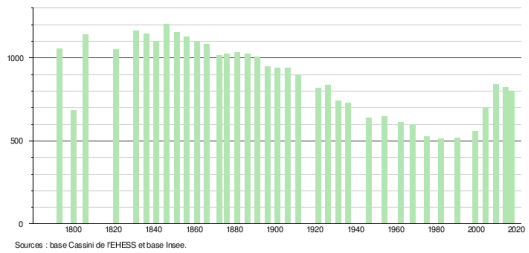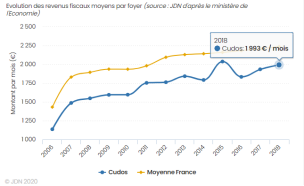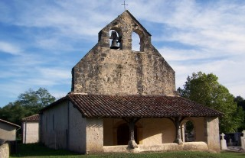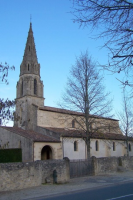Cudos, Gironde, Nouvelle-Aquitaine 作者: 来源: 发布时间:2021-06-10
I.Population and Area
Total Area: 34.21 km2
Population in 2017: 802
Population Density: 23 /km2

Histogram of demographic change
II.Natural Geography (environment and resources)
Cudos is a town in southwestern France, located in the Gironde department, in the Nouvelle-Aquitaine region.

Geography:
Municipality of Bazadais located on a low-altitude plateau, gradually lowering towards the south to the stream, the Barthos, a tributary of the Ciron.
The Landes forest occupies most of the territory.
The town is 66 km south-east of Bordeaux, capital of the department, 21 km south of Langon, capital of the arrondissement and 6 km south of Bazas, capital of the canton.
Bordering municipalities: The neighboring municipalities are Sauviac to the north, Birac to the northeast, Lavazan to the east, Lerm-et-Musset to the south-east, Escaudes to the south for about one kilometer, Bernos-Beaulac to the west and Marimbault to the north -west for about 500 meters.
Communication routes and transport:
The main road communication route is the national road 524 which does not cross the village and leads north to Bazas and south to Bernos-Beaulac and Captieux. The village is served by departmental roads of local interest, the D 932e6, the D 932e7 and the D 12e1.
The nearest access to the A62 (Bordeaux-Toulouse) motorway is number 3, called de Langon, which is 20 km north.
Access no 1, known as de Bazas, to the A65 motorway (Langon-Pau) is 8.5 km north-northeast. This highway crosses the west of the municipal territory.
The closest SNCF station is that of Langon, on the Bordeaux - Sète line of the TER Aquitaine, which is 21 km north.
Sources : http://www.cudos.fr/z/site.php?act=1_7
III.Economy
Employment rate (%): 73.7 (2017)
Average employment income (€):1 993 net per month (23 916 net per year)(2018)

Evolution of average monthly net wages
Sources : http://www.journaldunet.com/business/salaire/cudos/ville-33144
https://insee.fr/fr/statistiques/2011101?geo=COM-33144#chiffre-cle-8
IV.Industrial Characterisitics
lSectors of activity most represented in Cudos:
The table below lists the five sectors of activity with the most companies in Cudos during the period from 24/09/2019 to 24/09/2020 as well as the share of each sector on the total number of 'enterprises of the municipality.
Sector of activity | Number of companies | Share of companies |
Silviculture and other forestry activities | 26 | 20.0% |
Rental and operation of own or leased real estate | 26 | 20.0% |
Retail trade not in stores, stalls or markets | 6 | 4.6% |
Activities of other membership organizations | 6 | 4.6% |
Animal production | 5 | 3.8% |
The companies that generate the most turnover in Cudos
The list displayed below presents the companies established in Cudos and which declare the highest 2019 turnover in the municipality.
1)Soc Aquitaine De Traitements Des Eaux – Sate
Construction, maintenance and upkeep of purification and water treatment plants
SATE (Aquitaine Water Treatment Company) has been established in Aquitaine for over 10 years and works throughout the great South West.
We specialize in the treatment of industrial, wine and urban wastewater.
INEO AQUITAINE, a general partnership, has been active for 22 years.
Based in CANEJAN (33610), it specializes in the activity sector of electrical installation work in all premises. Its workforce is between 500 and 999 employees.
In 2019 it achieved a turnover of € 139,759,700.00.
The balance sheet total decreased by 4.57% between 2018 and 2019.
Societe.com lists 119 establishments and the last notable event of this company dates from 08-03-2019.
Jean LAFARGE, is a non-partner manager of the company INEO AQUITAINE.
Polyculture and cattle breeding (Bazadaise breed), Landes de Gascogne forest.
BAZADAISE is a French bovine breed, originating from the south of the Gironde, from Bazas of course.
With a muscular morphology and a beautiful gray dress, this former milk cow is best known for its beef qualities.
History:
Several hypotheses have been put forward to determine the appearance of the Bazadaise Race:
1)La Bazadaise would have existed in Roman times. According to J. COURREGELONGUE (thesis 1869), it would be one of the oldest races in the South.
2)"A breed left by the Moors as a monument to their passage" according to M. DUPONT, veterinarian in Bordeaux, member of the Société d'Agriculture en Gironde, in 1848.
3)Always based on ethnological theses, Professor GIRARD pleads for a crossing of the Iberian type with the Aquitaine type. C. DAUGREUILH (thesis 1929) holds this hypothesis as the most probable. The Iberian type, coming from the invasion of the Iberians, would be at the origin of the Pyrenean races. The crossing with the Aquitaine type would be very old, given the homogeneity of the population and the constancy of the transmission of the characters.
4)Some would like to make them an indigenous race, kept pure and free from foreign blood.
Originally used as a working breed, this breed saw its numbers drop sharply with the motorization of agriculture in the aftermath of World War II. La Bazadaise was then reoriented towards meat production.
While there were only 700 registered animals, a recovery plan was put in place in the 1970s.
In 1978, a genetic management program was put in place. Its first objective is to fight against consanguinity and to develop artificial insemination.
In 1992, the racial file was created, installed on the site of the Soual regional computer center (ARSOE).
Today, the BAZADAISE breed has 3,300 animals in the great south-west, from the Gironde to the Pyrenees mountains.
BAZADAISE EXCELLENCE
The EXCELLENCE BAZADAISE association is the national consultation body between partners leading an action or concerned by the genetic improvement of the Bazadaise breed.
The Bazadaise Breed Selection Body was approved in July 2008 and replaces the UPRA BAZADAISE (National Unit for the Selection and Promotion of the Bazadaise Bovine breed, created in 2003).
The Bazadaise cow has two essential qualities:
1)good maternal behavior
2)great ease of calving
3)A good width of the mother's pelvis and a fairly low birth weight (35 to 42 kg) of the calves contribute to easy calving.
Beef qualities and types of production
The excellent conformation and fineness of the skeleton translate into high carcass yields:
68 to 73% for veal
58 to 63% for the beef cow
60 to 65% for the beef
63 to 65% for the young bull
A good ease of fattening, a very fine grain of meat, an excellent flavor (good proportion of "marbling") allow the Bazadaise breed to stand out from other French suckling breeds.
Contact
05 56 25 11 67
excellence-bazadaise@orange.fr
Small factory manufacturing crates and pallets in Landes pine.
Small factory making chicken.
Sources:http://entreprises.lefigaro.fr/cudos/ville-33144
http://www.sate-epuration.fr/
http://www.cudos.fr/z/site.php?act=5_3
http://bazadaise.fr/z/index.php
http://bazadaise.fr/z/site.php?act=3_1
http://bazadaise.fr/z/site.php?act=2_2
V.Attractions
1.Amanieu d'Albret

When the Romans occupied Aquitaine, they reunited some chief towns by direct routes (around 200). Thus the Bazas-Sos section (near Condom) called 'Chemin Gallien', which crossed the moor in a straight line, has, in our sector, facilitated the development of some mediocre land near a stream: it is the origin of Artiguevieille, whose name means ancient clearing.
In 1165, Amanieu d'Albret gave the Cistercian monks of the Abbey of Fontguilhem (commune of Masseilles near Grignols) the land he owned in the parish of Artiguevieille (40 ha at the current location of Bideau), this donation probably corresponds to swampy land that needed to be drained, work in which the white monks were specialists.
To exploit these lands far from their abbey, the monks installed a 'barn', that is to say a large farm at a place where a path coming from the village of Artiguevieille joined the old Roman road Bazas-Sos. They played a big role in the development of the sector (roads, drainage).
The church of Artiguevieille already existed at the time when the Cistercian monks took possession of the lands of Amanieu d'Albret..
2.The church of Saint-Jean-l'Évangéliste

The church of Saint-Jean-l'Évangéliste, of Gothic architecture, was initially built in the middle of the town and the fourteenth century, altered and enlarged in the seventeenth century; its bell tower was added in the 19th century. It was listed as a historical monument in 1925.
The building, built in the 14th century, was enlarged in the 17th century with the addition of aisles to the nave and two side portals on either side of the central portal, then embellished with a bell tower in the 19th century; it is listed as a historical monument by decree of December 21, 1925.
It houses three remarkable protected altarpieces restored in 2003.
Presentation:
14th and 17th centuries.
The church was built on the initiative of Joan of Goth, in order to replace the primitive church, too small, raised in Conques.
The building, fortified as evidenced by the base of the bell tower, has been altered several times.
In the 17th century, two aisles were added, separated from the nave by two semicircular arches resting on octagonal pillars. The porch is then modified; the Gothic door is preserved in the center, and two side portals are made in the Renaissance style. In the middle of the 19th century, new improvement works were undertaken, and the addition of a bell tower was decided. Its construction, which began in 1859, is entirely financed by local collection.
Guided tour of church of Saint-Jean-l'Évangéliste
When you arrive from Bazas, the bell tower emerges and disappears according to the relief, this bell tower called "Cardinal Donnet Bell Tower" was the plume of the village.
The large porch with a gable roof hides the addition between the top of the bell tower: a modern spire, and the bottom: a square fortified tower. At the base there are only two large walls which frame the door; the tower does not begin to have four walls until a certain height and one reached it with a ladder, by an opening still in state, inside near the mechanism of the pendulum; this tower was originally capped by a small slate roof; the slots have been filled, but their traces are still visible and two of the four loopholes are still intact; they come out under the roofs, proof that the church was once lower. Between the two walls a stone arch from which one could bombard those who tried to force the door.
It is the memory of a time (until the 16th century) when the church, which was the only stone building, served as a refuge. The porch has long been the common room where we assembled, where the municipality met, where the school was held when there was one. The thick door, chiseled by time, bears the scars of successive locks; planks have been added to lengthen it down; with all that is not brought, the ground level rises around churches or old houses over the centuries, so that there have been three steps down into the church; to put it on the same level, it was necessary to plan the level of the cemetery by 80 cm and restore the door to its original length.
Address entered in the Mérimée database:
33430 Cudos - France
Insee code of the town: 33144
Gironde - Bordeaux - Aquitaine - New-Aquitaine
Approximate address from GPS coordinates (latitude and longitude):
7 Le Bourg-Ouest 33430 Cudos
Protected elements:
Church: registration by decree of December 21, 1925
History:
Gothic church including a fortified door.
Sources : http://www.cudos.fr/z/site.php?act=1_1
https://fr.wikipedia.org/wiki/Cudos#Culture_et_patrimoine
https://monumentum.fr/eglise-saint-jean-evangeliste-pa00083533.html
http://www.cudos.fr/z/site.php?act=1_2
VI.History
The discovery of 6 tumuli from the 3rd century BC reveals a human presence on the territory of the municipality during the Iron Age.
Unearthed in the Middle Ages by Cistercian monks, the territory of Cudos has been inhabited since antiquity as evidenced by the remains of a Roman settlement found in the hamlet of Conques. Very lively district, this hamlet, located to the north, on the edge of Bazas, had a church until the Revolution.
Many artisans work in Conques, and an inn allows pilgrims to Saint-Jacques-de-Compostelle to stop off. This hamlet constitutes the center of Cudos until the foundation in the 14th century, of the church of Saint John by Jeanne de Goth, sister of Pope Clement V.
Built further, this new church involves the displacement of the borough and the formation of the current village.
During the Revolution, the hamlet of Artiguevieille was integrated into the newly created commune.
Sources: http://www.cudos.fr/z/site.php?act=1_1
VII.Other information
Placement of a defibrillator:
A defibrillator has been placed on the facade of the village hall next to the entrance to the bar. The automation of this device is the ideal solution to achieve this goal. A user guide has been attached to the device. As soon as it opens, you will be guided by voice messages and illustrated pictograms of the procedure to follow.
The box is directly connected to the emergency services. Always keep in mind that this automated defibrillator will always perform an analysis of the patient's heart condition and will only deliver the electrical pulses if they are needed.
The emergency chalet
This emergency accommodation is intended for victims of disaster, family problems or placed at the request of social services, firefighters or gendarmerie.
In priority, are welcomed the inhabitants of the community of communes of the Bazadais.
Duration of reception: first 48 hours in emergencies then 1 to 15 days renewable 3 times for 3 people maximum.
Multi activity room
The municipal council on July 29, 2011 decided to create a multi-activity room of approximately 45 m² near the stadium. It is reserved primarily for the Sporting Club, but could also be used by other municipal associations during meetings or local events.
Solar lighting
Two solar street lights have been installed in front of the recreation center to illuminate this area and assess the efficiency and result of this type of lighting.
For the end-of-year decorations, the municipality has acquired 20 new motifs placed on the candelabra, from the rural multiple to the Bilh crossing. The facade of the town hall was decorated with two walls of LEDs and some garlands were placed on the trees.
Safety development around the school
In order to reduce the speed of users and to secure the entrance to the city, the construction of a central island with a speed bump was decided on the E932 departmental road on the outskirts of the school group.
Sources: http://www.cudos.fr/z/site.php?act=2_6
VIII.Contact information
Cudos town hall address :
Cudos Town Hall
7, the West Town
33430 Cudos
Mayor : Jean-Claude Dupiol (Mandate : 2014-2020)
Mail: mairie-cudos@wanadoo.fr
Phone number: 05 56 25 41 83
Fax: 05 56 25 47 39
Website : http://www.cudos.fr
Sources : http://www.cartesfrance.fr/carte-france-ville/33144_Cudos.html
